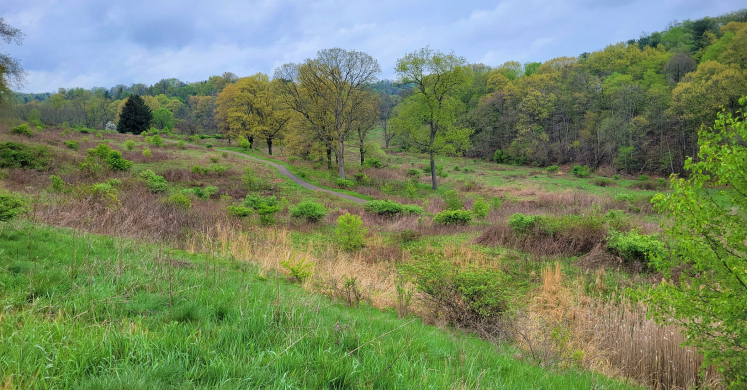Blog

#bioPGH Blog: Meadows and Lawns in the City, Part III
 A resource of Biophilia: Pittsburgh, #bioPGH is a weekly blog and social media series that aims to encourage both children and adults to reconnect with nature and enjoy what each of our distinctive seasons has to offer.
A resource of Biophilia: Pittsburgh, #bioPGH is a weekly blog and social media series that aims to encourage both children and adults to reconnect with nature and enjoy what each of our distinctive seasons has to offer.
The past few weeks on the blog, we have explored one of Phipps’ ongoing plant ecology research projects, a study that explores how lawns versus meadows compare as green infrastructure in cities. This week, we are going to look at some early results the researchers have found!
As a quick reminder, this project is focused on answering three main questions:
- How does the diversity of plants in a lawn versus a meadow change over time?
- How does the composition of a green space (lawn versus meadow) impact the health of the soil and influence the type of microscopic residents that can be found in the soil?
- How does composition of a green space impact the ability of a green space to remove toxic trace metals from soil and storm water?
Overall, a few key trends emerged from the data. The team found:
- Higher plant diversity in meadows than in lawns
- Higher microbial biomass and greater mycorrhizal fungal biomass in meadows than lawns
- More organic matter in lawns than meadows
- Higher carbon to nitrogen ratio in meadows than in lawns
- Higher heavy metal concentration in lawns than meadows
Most of these results were expected and made sense — we expected high plant diversity in meadows since by definition they are communities of many different plants rather than a monoculture of grass like a lawn. And as anticipated, a greater diversity of microbial life could thrive alongside a diverse plant community. This diversity ultimately keeps soil healthier long term. The greater mycorrhizal biomass seen in meadows means that in meadows, mycorrhizae, which are teeny-tiny fungal filaments in the soil, can hold on to soil and decrease erosion in addition to helping move nutrients through the meadow community.
There were higher concentrations of heavy metals in the lawn soil than in the meadows because the plant diversity and soil microbial communities of meadows may allow for better uptake of metals. Some plant species can draw up metals from the soil and some can’t, but when there are a variety of plants in a space, the odds are better that you will come across some that can. Trace heavy metals can be present in soil from legacy pollution or be washed in during rain events, so finding cost-effective green infrastructure solutions to manage this particular brand of contamination would be another benefit to both human and environmental health.
One meadow site was a bit of an outlier, though. Even though it was not managed as a lawn, it shared many measurable metrics that lawns did, like plant diversity and soil microbe life. When we look at the site up close, though, it has quite a bit of an invasive plant called Japanese stiltgrass, which humans accidentally brought to the US in 1919. Since this species is not eaten by our deer and outcompetes many native plants, it can overgrow in a habitat relatively quickly. This particular meadow is covered in stiltgrass to the point that the plant community mimics the monoculture (single species composition) of a lawn. In that context, it makes sense that this meadow is an outlier.
What does all of this mean in a practical sense? These results suggest that meadows have excellent potential as green infrastructure. Meadow soil is enriched from biodiversity above and below the ground, the ground is better stabilized, there is potential for contamination removal and all of these benefits can come from Pennsylvania’s own native plants.
“Maintaining urban green spaces is important to create natural habitats around the urban landscape,” Dr. Paudel says. “These habitats shelter various urban animals, including pollinators (bees and butterflies), help maintain biodiversity, assist with flooding control, erosion, soil conservation, and provide a healthy environment for humans. Although maintaining urban spaces is essential locally, they are vital to the global ecosystem as they help capture carbon and reduce global warming.”
Those are some things we all need! We can even help around our own homes by opting for native plants and including strips of meadow around our lawns. So let’s hear it for scientists, nature, and all of you readers excited about our wild world!
.jpg)
Dr. Shishir Paudel with Pitt students. Photo credit: Sara Kuebbing.
Photo credits: Header, Pexels, public domain. Cover, Maria Wheeler-Dubas (location, Churchill Greenway, Allegheny Land Trust.)

